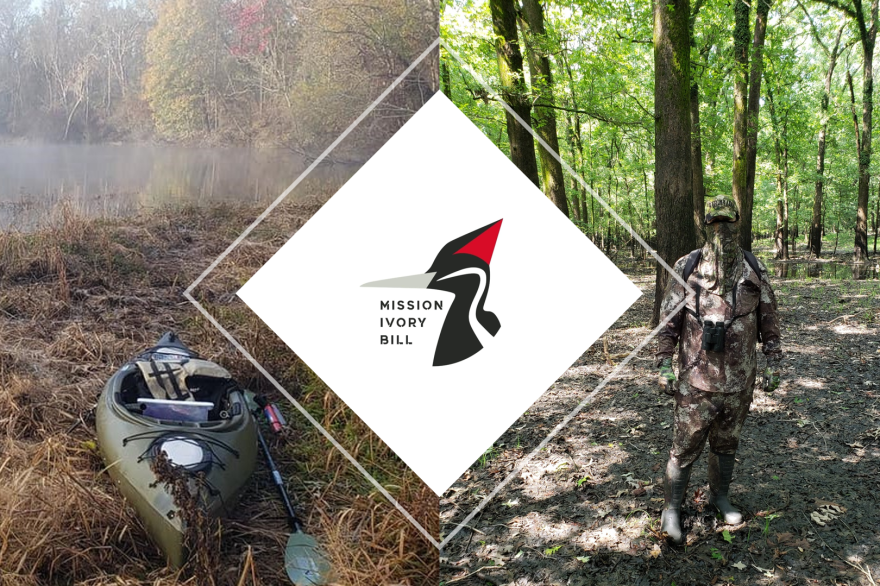Flocks of Ivory-billed Woodpeckers once soared through ancient old-growth upland pine and mature bottomland hardwood forests in southeastern North America. In flight, the wings of the giant black and white red-crested males span up to 30 inches. Ivorybills measure up to 20 inches in length, have piercing golden eyes and long ivory-colored beaks. Post-settlement logging, hunting and specimen collecting through the 1800s decimated the highly admired species.

By the 1930s, only a few dozen Ivorybills were surveyed in the deep South. The last official recorded sighting occurred in the early 1940s in the Tensas River National Wildlife Refuge in northeast Louisiana. Ivorybills were declared federally endangered in 1967. More than fifty years later, in 2021, U.S. Fish and Wildlife Service proposed declaring Ivorybills extinct.

Mission Ivorybill was deployed that year by Matt and Lauren Courtman. The couple reside in Monroe, Louisiana. Matt Courtman claims to have seen the bird and recorded its haunting "kent" calls. Mission Ivorybill leads field searches in northern Louisiana, south Arkansas, and western Mississippi, questing to prove the birds' presence. Teams silently explore remote forests and swamps, wearing camouflage and binoculars packing recording gear.
“We use ARU's, autonomous recording units, to try to locate areas where they are nesting overnight," Matt Courtman said, "looking for the golden hour when ivorybills call," at dawn or dusk.

Courtman is a former federal law clerk who's also served as president of the Louisiana Ornithological Society. He hosts free virtual boot camps and seminars with top Ivorybill experts in recent years focused on blocking the federal endangered species delisting declaration, which Courtman said will devastate existing remnant populations.
“The Ivorybill is the only organism that's protected under the Endangered Species Act that requires large unbroken tracts of bottomland hardwood forest, so the concern is that if the Ivorybill was delisted, then the federal property that contains bottomland hardwood forests might be fragmented for timber rights,” Courtman said.
Ivorybill enthusiasts all seek the same thing: clear photographic or video evidence of a bird in flight, pecking on decayed tree beetle larvae, or peeking out of a carved tree-trunk nesting cavity.

“Mission Ivory Bill acknowledges that we don’t have that," Courtman said. "No one has a magazine-cover quality photo, and we seek that. But probably the only way you're going to get that is to find an active [nesting] cavity. And so for us, we're very concerned. We don't want to chase the birds out.”
Ivorybills have adapted to relentless human incursion by constantly relocating deeper and deeper into impenetrable wilderness.
“I would say in 1880 there might have been two types of Ivorybills, loud Ivorybills and quiet Ivorybills," Courtman said. "By 1915, because their numbers were absolutely down by that point, there were probably only quiet Ivorybills.”
Field recordings gathered by Courtman of Ivorybills tapping on tree trunks, signature double knocks, and vocalizing kent calls are cited in a groundbreaking peer-reviewed science article published last May in Ecology & Evolution by National Aviary/Project Principalis. Lead authors Steve Latta and Mark Michaels, along with a diverse team of national scientists, spent a decade exploring Ivorybill habitat in northern Louisiana starting in 2012, logging visual encounters, installing trail cameras and AI audio recording units. A drone video taken in October 2022 caught two Ivorybills in flight, landing on a tree branch, adding to possible proof that the bird persists, as the authors suggest.
We sought comment from Latta and Michaels on the Ivorybill's federal extinction reprieve. A National Aviary spokesperson responded, emailing that the "conservation of the Ivorybill and its habitat can be accomplished if the bird remains on the endangered species list and not declared extinct." Federal endangered status conveys strict habitat protections for species.

The very first coordinated search for Ivorybills involving federal and state wildlife agents, scholars, Cornell Lab of Ornithology and The Nature Conservancy traces back to 2004 to a place called the Big Woods on the Cache River National Wildlife Refuge in east central Arkansas. Investigators secretly swarmed the site after seven purported independent Ivorybill sightings had occurred. In 2005, the search was publicly declared to be a "rediscovery" of the species. That’s also where University of Arkansas Little Rock professor of electronics David Luneau, while paddling through a cypress swamp, captured several minutes of video of what he claims to be an Ivorybill taking flight and flapping off through the forest.

Luneau and other key Ivorybill experts have been featured guests on Mission Ivorybill's virtual broadcasts. But Matt Courtman credits U.S. Fish and Wildlife Service regional refuge biologist William Hunter with confirming the bird’s existence in the swamps of Arkansas in published findings.
“He did a great job in analyzing the arguments for and against the Arkansas rediscovery evidence, and he unambiguously found in favor of the evidence showing that was an ivory-billed woodpecker,” Courtman said.
Courtman also acknowledges U.S. Department of Interior Secretary Deb Haaland for her tacit role in trying to preserve the elusive Ivorybill and, by extension, its ecologically valuable forest habitat.

To verify the existence of ivorybills, USFWS conducted a five-year species status review completed in 2019, resulting in a recommendation to declare the bird extinct. That was followed by public comment periods in 2021 and 2022, with many coming forward in defense of the bird. In the end, the agency found that possible sightings of Ivory-billed woodpeckers are inconclusive or are misidentifications. A final ruling was expected to be issued on the deadline last spring. On Oct. 16, the agency delisted 21 species from the Endangered Species Act due to extinction. Ivorybills were absent.
We queried U.S. Fish and Wildlife Service about how long it will take to issue a final determination. We were told no new deadline has been set, nor has the federal 2021 Ivorybill extinction declaration proposal been withdrawn. Federal wildlife scientists, in the interim, will continue to analyze current and incoming evidence, leading up to a final decision on the fate of the majestic Ivory-billed woodpecker.








